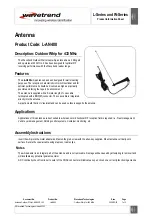
Internet Communication Module 7845i-GSM Installation and Setup Guide
3-8
Alternative Modes (Zone Trigger, 4204 and Two-4204)
Zone Trigger Mode
There are six input zones available on the 7845i-GSM. Each zone is selectable for +V, -V, or
EOLR trigger. The first zone input can detect both pulsed and steady signals if connected to
a bell output. Additionally, the first zone input can be programmed to detect a single pulse
(characteristic of a Panic indication on the Lynx, LynxR or LynxR-EN control panel by
enabling the Lynx Panic option). If the programming option “Lynx Panic” is enabled, the
7845i-GSM reports an alarm on zone 3. No restores are reported for this zone. If this option
is selected, the second physical zone input is ignored.
When using Zone Trigger mode, messages are sent in ADEMCO High-Speed format.
Zones 3, 4, 5, 6 and 7 are voltage trigger inputs located on TB1 pins 6-10. If the Lynx Panic
feature is being used, do not connect zone 3 (the second physical zone input).
Refer to Table 5 for Zone Trigger Mode programming and follow the prompts that pertain to
Zone Trigger Mode.
A check mark (
✔
) indicates whether the prompt applies to that mode.
4204 Emulation Mode
In 4204 Emulation Mode, the 7845i-GSM communicates with a compatible Honeywell VISTA
series or First Alert control panel as though it were a 4204 Relay Module. If two 4204s are
enabled in the module, it acts as two 4204s at consecutive device addresses. The control
panel must be configured to recognize one or two 4204 relay modules accordingly. On
VISTA-32FB (or higher) control panels and First Alert equivalents, addresses 6 and 13
should not be used when the secondary 4204 is enabled. Messages are sent in ADEMCO
High-Speed format.
NOTE:
See your control panel Installation and Setup Guide for the number of 4204 modules
supported. The LynxR-I does not support 4204 mode.
4204 Emulation Mode Options
For control panels that do not support LRR-ECP communication, the 4204 Emulation modes
provide a means of sending up to eight unique reports based on defined system conditions. In
4204 mode, the 7845i-GSM functions as a logical 4204 Relay Module, where each relay
number, referred to in the module as zone number, can be programmed to send a report
based on the output function programmed in the control for that relay. Each relay-zone can
also be programmed to send a restore message of the reported condition, can be set to delay
transmission of messages, and can be programmed to send reports only when a conditional
zone is triggered (armed), (see
Zone Input Options
later in this section).
In single 4204 mode, the 7845i-GSM supports up to four relay-zones. In Two-4204 mode, the
7845i-GSM functions as two 4204 modules, supporting up to eight relay-zones.
4204 Relay Outputs map to 7845i-GSM zones as follows:
First 4204 Zones
(device address entered in Question 5)
:
Second 4204 Zones
(device address entered in Question 5, plus 1)
:
Relay 1 = Zone 1
Relay 2 = Zone 2
Relay 3 = Zone 3
Relay 4 = Zone 4 or conditional zone trigger if
“report only if armed” is selected in any zone 1-3
when using single 4204 mode.
NOTE:
Zone 4 status is not reported when being
used as the conditional (arming) trigger zone.
Relay 1 = Zone 5
Relay 2 = Zone 6
Relay 3 = Zone 7
Relay 4 = Zone 8 or conditional zone trigger if
“report only if armed” is selected in any
zone 1-7 when using Two-4204 mode.
NOTE:
Zone 8 status is not reported when being
used as the conditional (arming) trigger zone or if
tamper reporting is enabled.
When using the 7845i-GSM in 4204 Emulation Mode, DO NOT enable the Long-Range Radio
module reporting in the control panel programming. Instead, enable 4204 relay module
address(es) and program the appropriate relay activation functions for the relay-zones being
















































